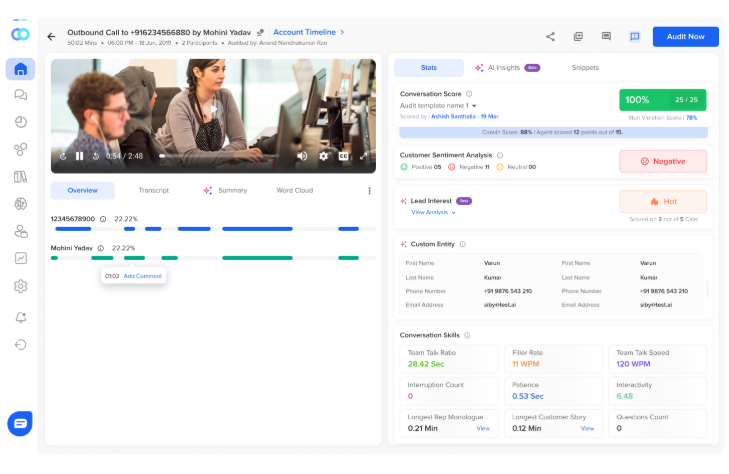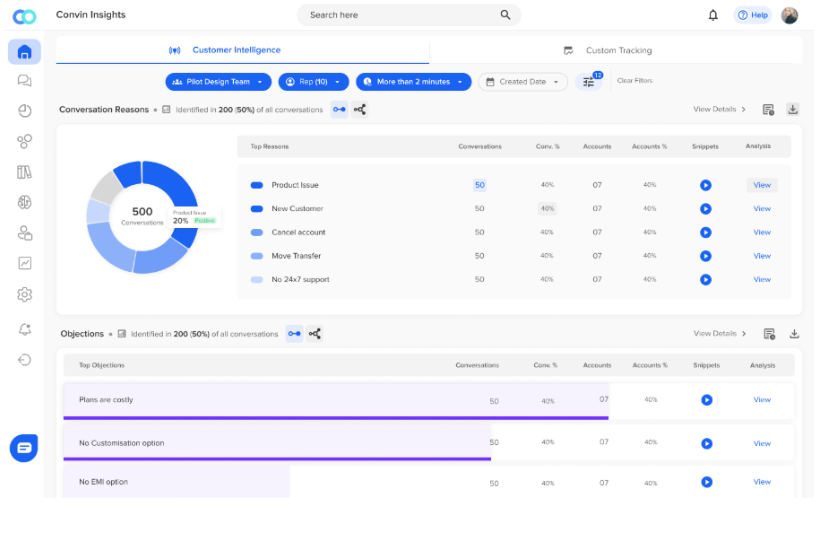In today’s insurance landscape, the battle for customer loyalty has expanded far beyond policy pricing. A staggering 86% of insurance consumers say they’re willing to pay more for a better experience, yet many insurers still struggle to deliver.
This reality puts insurance customer experience at the centre of competitive advantage and retention strategy.
In this blog you’ll discover how leading insurers are turning every interaction, from onboarding to claims and renewals, into opportunities to increase satisfaction, deepen loyalty and grow profit.
We’ll explore how personalization shifts the dynamic, why omnichannel engagement matters, how to measure CX success, and how tools like real‑time intelligence and feedback analytics make it all operational.
If you’re ready to transform your insurance customer experience with practical insights, measurable metrics and next‑generation tools, keep reading.
Explore Convin, a smarter CX tools insurance leaders rely on
Why Insurance Customer Experience Is a Game Changer Today
In the crowded insurance market, delivering a standout insurance customer experience is no longer optional, it’s critical. Insurers that consistently delight policyholders don’t just improve satisfaction, they boost retention, reduce churn and drive meaningful profit. Research shows that a mere 5% increase in retention can boost profitability by 25%‑95%.
For insurance providers, where acquisition costs are often high and margins thin, shifting the focus to retention means every positive interaction, from onboarding to claims, becomes a strategic asset.
1. Improving customer satisfaction in insurance through personalization
Personalization in the insurance sector is becoming a defining factor in how insurers elevate the insurance customer experience. When companies tailor offerings, communications, and servicing to the individual policyholder rather than relying on one‑size‐fits‐all models, customers feel valued and understood.
Research shows that personalization in insurance can boost revenue by 10‑15% and raise customer retention by up to 20%.
Beyond numbers, the real value lies in turning routine interactions—such as policy renewals or claims updates, into opportunities for engagement. For example, when an insurer proactively offers a micro‑policy based on a customer’s lifestyle changes, the experience shifts from transactional to relational.
That shift leads directly into stronger customer retention insurance behaviours and greater satisfaction. Reduce CES by simplifying product discovery. A life insurer that guides visitors through a “Discover–Design–Engage” flow and explains complex products like IUL in plain language lowers confusion and speeds decisions. Prospects can explore coverage with Everly via a streamlined homepage journey that pairs quick education with clear next steps—moving from interest to quote with less friction. When CX teams benchmark against such journeys, they uncover copy, layout, and CTA patterns that improve online conversion and reduce contact-center load.
2. How insurance CX strategy impacts brand loyalty and retention
A well‑executed insurance CX strategy does far more than improve satisfaction, it anchors brand loyalty and drives long‑term policyholder retention. According to a market study, 60% of insurance customers say they would switch providers after a poor service experience. When loyalty falters, retention suffers, profits dip, and customer acquisition costs rise.
Effective strategies weave customer experience optimization into every touchpoint: onboarding, claims, self‑service, and beyond. They emphasize ease of doing business, digital convenience, and meaningful human connection.
That holistic approach doesn’t just keep customers, it turns them into advocates. Over time, this becomes a core part of the insurer’s growth engine.
3. Why customer retention insurance strategies drive long-term profit
Retention isn’t just a feel‑good metric, it’s a profit driver. For insurers, acquiring a new customer is significantly more expensive than retaining one. Evidence shows that a 5% increase in retention can generate a 25% to 95% increase in profits.
But making retention happen requires more than renewal reminders. It demands consistent and positive insurance customer experience across the customer lifecycle. This includes timely updates, proactive risk advice, and seamless servicing.
When a policyholder feels the insurer is invested in their well‑being, they’re less likely to shop around and more likely to engage in cross‑sell and upsell opportunities, further increasing lifetime value.
Delivering great experiences starts with how insurers engage across channels and moments that matter.
Map key retention triggers in your policyholder journey with Convin
Smarter Engagement: The Backbone of Insurance Customer Experience
Modern policyholders expect fast, contextual, and cross-platform interactions. According to McKinsey, insurers using smart engagement tools see a 20-40% increase in customer satisfaction and retention.
Smart engagement isn’t just about being present, it’s about being proactive and consistent across touchpoints. Leading insurers now integrate data-driven communication, automation, and AI to turn every interaction into a CX advantage.
1. Role of omnichannel insurance engagement in boosting satisfaction
In today’s fast‑moving digital age, policyholders expect to switch effortlessly between channels, mobile app, web portal, phone, chat, and receive the same high‑quality experience.
Insurers that adopt true omnichannel insurance engagement see meaningful results: one behavioral study found service‑channel users were 25% more likely to renew their policy when they engaged across multiple channels.
The trick isn’t just to offer multiple channels, it’s to unify them. When an insurer’s app, call center, and chat function share the same customer context, the experience feels seamless. This consistency reduces friction, boosts satisfaction, and improves the overall insurance customer experience.
2. Driving customer retention insurance-wide with proactive service
Proactive service is a hallmark of leading CX strategies in insurance. Instead of waiting for a claim or customer complaint, insurers are using predictive analytics and real‑time insights to anticipate needs: policy renewal alerts, risk mitigation tips, and personalized coverage reviews.
Studies show that customers who receive timely follow‑up after claims are three times more likely to stay with their insurer.
By embedding proactive engagement into the insurance customer experience, insurers reduce surprise, build trust and raise the bar on service.
These efforts create endurance in retention insurance models, keeping customers longer and deepening their relationship with the brand.
To sustain these engagement gains, insurers need clear visibility into what’s working, and what isn’t.
Automate proactive service touchpoints across your lifecycle with Convin
This blog is just the start.
Unlock the power of Convin’s AI with a live demo.

How to Measure Customer Experience and Prove its ROI
Measuring the customer experience in the insurance sector is foundational to continuous improvement. A Gartner study found that 70% of CX leaders struggle to connect metrics with business outcomes.
Without the right KPIs, tools, and attribution models, even the most well-funded strategies fall flat. Insurers must focus on actionable, real-time measurement to understand what drives satisfaction, loyalty, and revenue, and optimize accordingly.
1. Key metrics for customer experience optimization
You can’t optimize what you don’t measure, and that holds especially true for insurance customer experience.
To track and improve, insurers use metrics like
- CSAT (Customer Satisfaction Score),
- NPS (Net Promoter Score),
- CES (Customer Effort Score), and
- First Contact Resolution (FCR).
Each of these has a distinct purpose: CSAT measures immediate satisfaction after a touchpoint, NPS gauges long‑term loyalty, CES reveals friction in the journey, and FCR measures operational efficiency.
By monitoring them together, insurers can see how well their insurance CX strategy is working and where the gaps lie.
2. Tools that capture customer sentiment and feedback in real time
Capturing feedback is important, but interpreting it is where value lies for insurance customer experience optimization.
Modern insurers are turning to tools such as
- sentiment analysis
- speech analytics and
- voice of customer software to extract insight from calls, emails and chats.
One market report states that the voice analytics market in insurance is growing because companies need to understand sentiment, preferences and pain points in real time.
By transforming unstructured feedback into actionable data, insurers can spot systemic issues, coach agents more effectively and prioritize process improvements. This tool‑driven insight loop is a powerful lever in any insurance CX strategy.
3. Measuring the ROI of your insurance CX strategy
Investing in customer experience is one thing, proving its value is another. Many insurers struggle to tie satisfaction efforts directly to business outcomes.
A Forbes article highlights that measuring ROI for CX requires a blend of quantitative and qualitative metrics and a long‑term view.
To be meaningful, ROI measurement must link experience metrics (like NPS or retention) with financial indicators (such as repeat business, claim frequency, or cross‑sell rates). When done right, insurers can present CX investments not as cost centres but as profit engines.
True CX transformation demands technology that not only listens but acts in real time.
Use Convin’s sentiment tools to analyze real customer feedback
How Convin Supercharges Insurance Customer Experience
Convin’s AI-powered platform is purpose-built to modernize how insurers deliver insurance customer experience. By combining real-time support, conversation intelligence, and voice-of-customer insights,
Convin enables insurance teams to act quickly, coach more effectively, and close CX gaps fast. The result? Improved satisfaction, higher retention, and better operational efficiency across contact centers.

1. Real-time agent assist for improving customer satisfaction in insurance
When insurers adopt real‑time agent assist, they empower agents with live‑call guidance that elevates the insurance customer experience in real time. Convin’s platform delivers live coaching during calls, offering instant prompts and next‑best‑action suggestions so agents can adapt mid‑conversation.
Automatic compliance alerts reduce risk and mis‑selling by flagging deviations from script or policy standards as they happen, especially important in the tightly regulated insurance space.
And because tone, empathy and personalization matter, Convin surfaces empathy prompts aligned with the customer’s mood and language, helping agents shift from transactional to relational conversations.
Together, these capabilities improve first‑contact resolution, reduce average handle time, and ultimately enhance the insurance customer experience by ensuring every live interaction is on‑script, compliant and customer‑centric.

2. Conversation intelligence for customer retention insurance teams
Retention is driven by understanding why customers leave and what keeps them. Convin’s conversation intelligence analyzes 100% of calls, chats and emails to uncover trends, hidden risks and retention‑trigger events.
It builds scorecards and QA automation for agent performance, replacing random sampling with full‑coverage analytics so insurers can coach with precision.
And perhaps most strategically, it delivers insights about why policyholders churn, and what wins them back, enabling retention insurance teams to act early, tailor offers and measure impact.
In short, conversation intelligence doesn’t just log interactions, it transforms them into actionable intelligence that protects retention, supports cross‑sell and improves the insurance customer experience.
3. Voice of customer software for CX insights and sentiment analysis
To optimize insurance CX, you need to hear your customers, not just speak to them. Convin’s voice of customer software captures feedback from calls, chats, emails and surveys across channels.
It turns this unstructured feedback into actionable CX strategies through sentiment analysis, topic extraction and trend dashboards, letting insurers spot systemic issues before they snowball.
And with real‑time dashboards highlighting gaps in service delivery, insurers can monitor “customer mood”, agent performance and process bottlenecks, closing the loop between insight and action.
By integrating voice‑of‑customer insights, insurers raise the bar on the insurance customer experience, making continuous improvement less aspirational and more operational.
Putting it all together, the path to loyalty lies in turning CX into a measurable, continuous advantage.
Monitor CX gaps using Convin’s VOC dashboard
Mastering Insurance Customer Experience for Long-Term Loyalty
Mastering the insurance customer experience isn’t about one-time fixes, it’s about consistent, scalable actions that meet evolving policyholder expectations. From omnichannel engagement to real-time personalization, the insurers who win are those who connect the dots between service, sentiment, and strategy.
Smart engagement and data-backed decisions turn every policyholder interaction into a loyalty-building opportunity.
Tools like Convin help make this a reality by surfacing insights, supporting agents live, and ensuring customer sentiment drives operational change—without disrupting existing workflows.
In a market where experience now defines value, the next move is clear: invest in CX systems that can adapt, scale, and deliver.
Ready to see how leading insurers are doing it? Explore what’s possible with Convin.
FAQ
1. What are the 4 P's of customer engagement?
The 4 P’s of customer engagement are Personalization, Proactivity, Performance, and Presence. In the insurance customer experience context, these elements help insurers deliver consistent, meaningful interactions that drive satisfaction and loyalty across all touchpoints.
2. What are the 3 C's of customer satisfaction?
The 3 C’s refer to Consistency, Clarity, and Communication. These principles ensure that customers receive reliable service, transparent information, and timely updates, key to optimizing the insurance customer experience and reducing churn.
3. What tool is helpful in improving customer satisfaction?
Convin’s conversation intelligence platform is one of the most effective tools for improving customer satisfaction in insurance. It offers real-time agent assist, voice of customer insights, and full interaction analysis to identify gaps and optimize performance.
4. What strategy is best to improve customer satisfaction?
The best strategy combines personalized engagement, omnichannel support, and real-time feedback analysis. For insurers, integrating platforms like Convin enables data-driven decision-making and consistent customer experience optimization.








.avif)